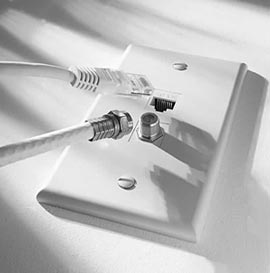May 2002
More and more, Internet users are finding Web browsing a lot less fun these days - unless they have the right connections. Slow dial-up connection speeds may have been tolerable when you first tried out the Internet. Back then, we were all eager to peek at exotic Web sites, buy books and sell old collector items from the attic. It took a little time to load the pages, but so what?
Now that the initial excitement has worn off, those tens of seconds seem excruciatingly long. Dial-up access just doesn't measure up anymore.
The Broadband Experience

Of course, fuzzy images and bad reception didn't doom television. Eventually, technology catches up, and high quality becomes the norm. For the Internet, broadband has come to symbolize that experience. Some bumps and glitches occurred in getting the technology up, but they have given way to mostly satisfying experiences.
Originally a technical term, "broadband" is now the popular name for any high-speed Internet access, including digital subscriber line (DSL) and cable technologies. Typical speeds range upward from 384 kilobits per second (that is, 384 kbps) to 8 megabits per second (8,000 kbps) and even higher, depending on a variety of factors. That's many times faster than a maximum 56-kbps dial-up connection.
Already, more than 12 million American homes have broadband access, and this number keeps growing. It is estimated that broadband service is available to 45 percent of U.S. households over ordinary telephone lines and to 70 percent over cable television lines. So there is a good chance that broadband is available to you from your local telephone or cable TV company.
Broadband over Telephone Lines
Researchers recognized the need for high-speed communications over phone wires many years ago. They explored the limits and described the equipment needed to filter out the noise that can interfere with high-speed data transmissions over ordinary copper voice-grade telephone wires. They found that it is possible to transmit data at a rate of several megabits per second over two or three miles of copper and even more data over shorter distances. That's a lot faster than a dial-up connection - about 40 times faster by some estimates, which means you wait one second instead of 40 seconds.
Now that the broadband equipment is in place at the phone companies and inexpensive (or sometimes free) broadband modems are available, a DSL connection is a real choice for millions of homes. An important advantage of DSL is that your phone line is not shared with others, so reliable speeds can be maintained. It's worthwhile to determine what DSL services are available in your neighborhood, either from your phone provider or an alternative source.
Connecting through Cable
A single coaxial cable of the type used in the cable TV system can carry data at rates of hundreds of megabits per second, in part because the design of the cable shields it from interference. Now you can get broadband access over the same cable.
There are some important differences between cable and DSL. Normally the same service cable carries many different channels to a couple of hundred homes at the same time. That's the way cable works - many channels, all on the same cable and available to everyone in the neighborhood. For Internet access, one or more of these channels are dedicated to broadband, requiring a cable modem at the subscriber end to decode the signals. When several households are online at the same time, sharing the bandwidth of these channels, congestion and slowdowns can result.
Which is Right for You?
Your "best" choice is broadband, which is vastly superior to a dial-up service. Right now and for the foreseeable future, either DSL or cable-modem is your best option (although broadband satellite access is also being offered in some places). Depending on the location, they are priced competitively, and startup costs are often borne by the provider as an incentive to get you to sign up.
It may be worthwhile getting a high-speed Internet connection, especially if you have a fast computer and are already paying high fees for dial-up. For a modestly higher investment compared to dial-up service you can discover the Internet all over again. What are you waiting for?
For additional information about broadband communications over copper wires, visit our Telecommunications section.
